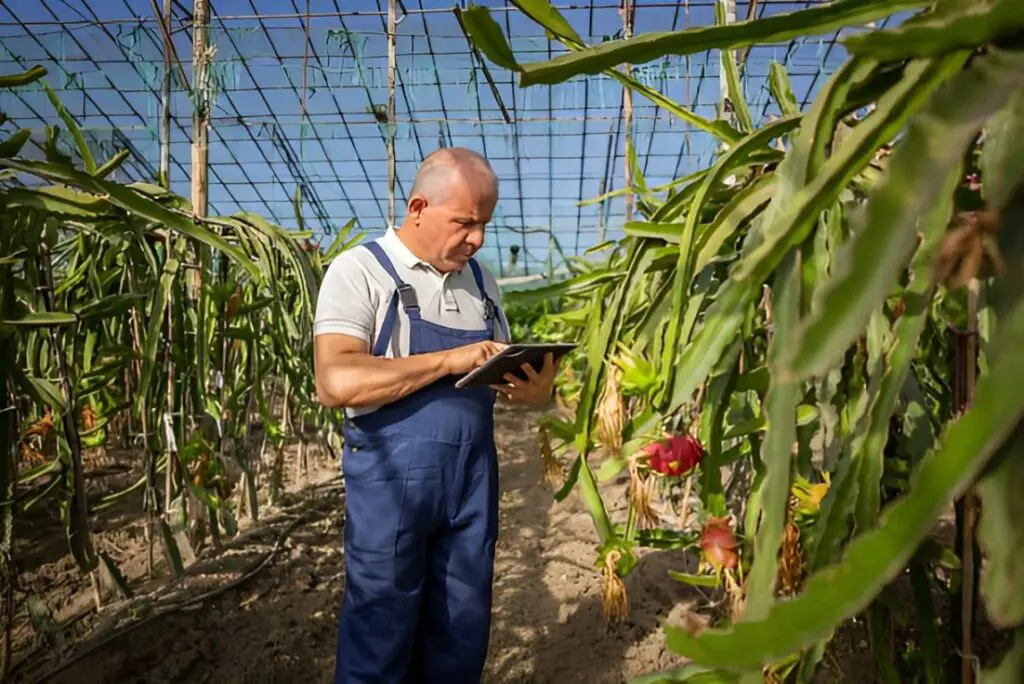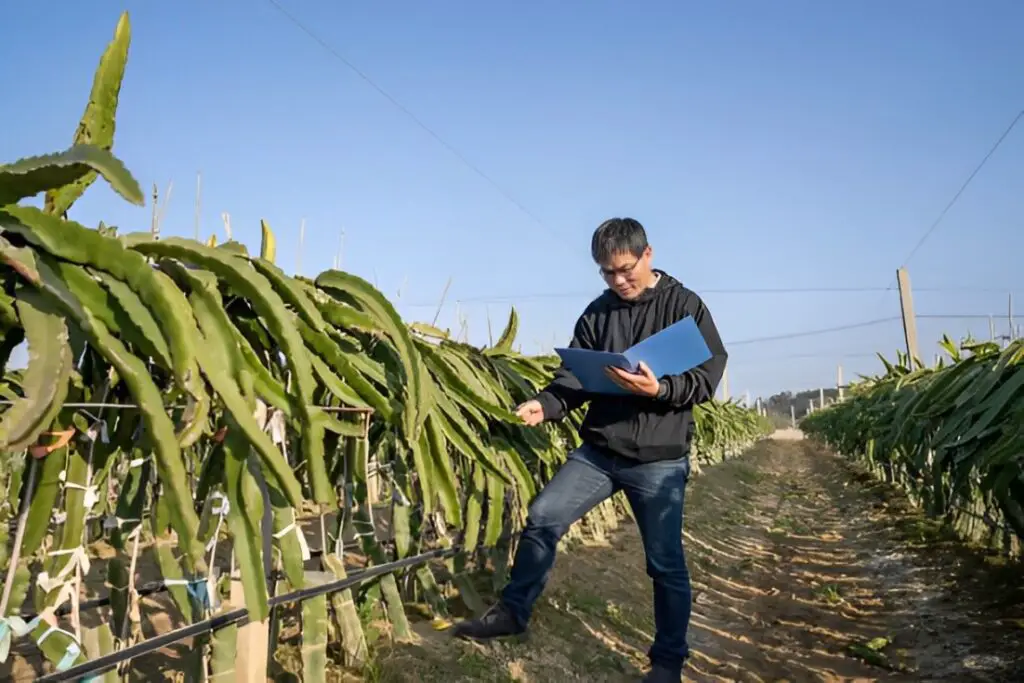Dragon fruit, also known by names like Pitaya and Kamalam, has gained popularity worldwide due to its unique appearance and numerous health benefits. With an increasing market demand Dragon fruit farming challenge, especially among health-conscious individuals, many farmers in India have started to consider dragon fruit farming as a profitable venture. However, despite its popularity and the potential for high profits, many farmers face failures in their attempts to grow this fruit. In this article, we will discuss the reasons why dragon fruit farming often leads to failure and how farmers can avoid these pitfalls.
Dragon fruit farming challenges & Profits

The Rise of Dragon Fruit in India
As you all know Dragon fruit farming challenges and its market is becoming increasingly popular in both India and Asia due to the rising demand for the fruit. Its health benefits, including high vitamin C content, antioxidants, and fiber, have made it a favorite among health-conscious consumers. As a result, many farmers view it as a lucrative alternative to traditional crops. With proper techniques and resources, dragon fruit farming can bring in significantly higher profits, making it an attractive choice for farmers.
Dragon Fruit Farming in India’s Climate
Dragon fruit grows best in a dry, subtropical climate. The key regions in India where it is cultivated include Gujarat, Maharashtra, Karnataka, and Andhra Pradesh. The plant thrives in these areas due to their dry, hot weather conditions, which are ideal for dragon fruit growth.
Increased Production Potential
India has significant potential for growing dragon fruit, especially if the right farming techniques and resources are used. With the increasing demand and Dragon fruit farming challenges, there is a large scope for expanding its production. However, farmers must understand the plant’s requirements and the challenges involved to tap into this potential fully.
Why Do Farmers Fail at Dragon Fruit Farming?

1. Lack of Knowledge and Training
One of the most significant Dragon fruit plant problems, why farmers fail at growing dragon fruit is a lack of knowledge and proper training. Dragon fruit is an exotic plant that requires specific care and techniques. Many farmers, especially those who are new to this type of farming and facing Dragon fruit farming challenges, lack the expertise needed for successful cultivation. They may not know the ideal soil conditions, the correct amount of water and fertilizer, or how to protect the plant from diseases.
Moreover, farmers often don’t understand the importance of practices like pruning, setting up the right support structures, and harvesting the fruit at the right time. Without proper training, farmers are unable to manage these factors effectively, leading to poor yields and low-quality fruit.
Farmers who are provided with training on modern agricultural practices, soil management, and pest control can increase their yields and produce higher-quality fruit, leading to more significant profits.
2. Climate Instability
Excessive Rainfall and Drought
Dragon fruit plant problems are various like they are very sensitive to climate changes. Excessive rainfall, especially during the monsoon season, can result in waterlogging, causing root rot and plant death. Conversely, drought conditions can lead to sunburns and make it difficult for the plants to absorb enough water. This causes stress to the plants, impacting their growth and fruit production.
All the Farmers must and when I am saying this should implement proper irrigation techniques to manage water levels effectively. Using drainage systems to prevent waterlogging and providing shade to protect the plants from intense sun exposure can help mitigate these issues.
Temperature Fluctuations
Dragon fruit plants are sensitive to sudden temperature changes. They thrive in a temperature range between 10°C and 38°C. Sudden heatwaves or drops in temperature can cause the plants to go into stress, affecting their growth. High temperatures can lead to sunburn, while cold temperatures can weaken the plant, leading to poor growth and increased susceptibility to diseases.
To manage Dragon fruit plant problems, farmers can use techniques like shading nets or miracle kaolin clay sprays to protect plants from sunburn. Creating an optimal environment through temperature control techniques can greatly improve the quality and yield of dragon fruit.
3. Soil Quality and Nutrient Problems
Dragon fruit plants require well-draining soil that is slightly alkaline, rich in organic matter, and capable of retaining moisture. In India, many regions have heavy, clayey soil that does not meet the plant’s requirements so this leads to water retention problems, which can effect the growth of the plant.
Additionally, soil in some areas lacks essential nutrients like nitrogen, phosphorus, and potassium, which are crucial for the plant’s growth. Without proper nutrients, the plants become weak, and their growth is stunted, leading to poor fruit production.
Farmers must test their soil regularly and use organic fertilizers like compost or green manure to improve soil quality. Using the right fertilizers and maintaining soil health can help enhance dragon fruit growth and increase yield.
4. Incorrect Pricing of Products
Pricing is another challenge faced by dragon fruit farmers. While the demand for dragon fruit is increasing, Dragon fruit plant problems and farmers often struggle to get a fair price for their products. Middlemen, who act as intermediaries between the farmers and consumers, often purchase the fruit at a low price and sell it at a higher price, leaving the farmers with minimal profits.
Moreover, market imbalances in demand and supply can lead to fluctuating prices, further affecting farmers’ income. If farmers can establish direct relationships with consumers, local supermarkets, or online platforms, they may be able to sell their produce at better prices.
5. Export Challenges

Although the global market for dragon fruit is growing, farmers in India face several Dragon fruit plant problems when it comes to exporting their produce. The process of exporting involves meeting international standards, obtaining certifications, and ensuring the fruit passes quality control. These requirements can be costly and complicated for small-scale farmers.
Furthermore, high logistics and storage costs further reduce farmers’ profits. If the export process is made more accessible through better regulations and financial assistance, farmers could benefit from international markets, increasing their income.
6. Ineffective Implementation of Government Schemes
The Indian government has launched several schemes to support Dragon fruit farming challenges, including subsidies, training, and financial assistance. However, the implementation of these schemes is often slow or ineffective. Many farmers are unaware of the schemes or face delays in receiving the benefits.
To improve the situation, the government must enhance awareness about these schemes and ensure their timely implementation. Providing farmers with the necessary resources and support can significantly improve the chances of success in dragon fruit farming.
7. Lack of Awareness About Advanced Agricultural Techniques
Farmers often fail to adopt modern agricultural practices, which could significantly improve their crop yield and quality. Techniques such as greenhouse farming, mulching, and drip irrigation can help mitigate the effects of extreme weather conditions, conserve water, and improve soil quality.
By using these modern techniques, farmers can protect their plants from weather extremes and reduce the risk of crop failure and Dragon fruit plant problems. These practices lead to better yields, higher-quality fruits, and more profitable farming.
Tips for Successful Dragon Fruit Farming
- Start Small: Begin with a trial by planting a small number of dragon fruit plants. Observe their growth throughout the year to understand their needs.
- Research and Training: Educate yourself about the plant’s requirements and seek professional training to improve your farming techniques.
- Monitor the Climate: Keep an eye on weather patterns and take steps to protect the plants from extreme temperatures, heavy rainfall, and drought.
- Improve Soil Health: Regularly test the soil and use organic fertilizers to improve its quality and nutrient levels.
- Avoid Overwatering: Dragon fruit plants are prone to root rot due to excess water proper care is mandatory. Ensure proper drainage to avoid waterlogging.
- Adopt Modern Techniques: Use advanced farming practices like greenhouse farming, mulching, and drip irrigation to optimize plant growth.
- Establish Direct Market Links: Avoid intermediaries by selling directly to consumers, local markets, or supermarkets to get better prices for your produce.
- Seek Government Support: Take advantage of government schemes and subsidies that promote dragon fruit farming. make sure to arrange all the resources in the very beginning of the farming period.
- Protect Against Pests and Diseases: Regularly inspect plants for pests and diseases and take preventative measures to protect your crops.
- Stay Informed: Stay updated with the latest farming techniques and market trends to adapt to changing conditions and maximize your profits.
Frequently Asked Questions (FAQ)
- Tell me the Right time to plant dragon fruit?
- The ideal time for planting dragon fruit is during the warm season when the temperature is between 20°C and 30°C.
- Dragon fruit plants water requirement?
- Dragon fruit plants need regular watering, but overwatering should be avoided. Ensure proper drainage to prevent waterlogging.
- Can dragon fruit be grown in all types of soil?
- No, dragon fruit requires well-draining, slightly alkaline soil. Heavy or waterlogged soil is unsuitable for growth.
- dragon fruit plants first fruiting time?
- Dragon fruit plants typically start producing fruit 1 to 2 years after planting, depending on the variety and growing conditions.
- What are the common diseases that affect dragon fruit plants?
- Common diseases like fungal root rot, infections, and bacterial blight. Proper care and disease management techniques can help prevent these issues.
- How can I protect dragon fruit plants from sunburn?
- Use shading nets or sprays like miracle kaolin clay to protect the plants from direct sunlight, especially during hot weather.
- Can dragon fruit be grown in containers?
- Yes, dragon fruit can be grown in containers, provided the container has good drainage and is large enough to support the plant’s root system.
- What are the key nutrients for dragon fruit growth?
- Key nutrients include nitrogen, phosphorus, and potassium. Regular fertilization is essential to ensure healthy growth.
- How do I prevent root rot in dragon fruit?
- manage proper drainage, avoid overwatering, and use/make well-draining soil to prevent root rot.
- Is it possible to grow dragon fruit organically?
- Yes, dragon fruit can be grown organically using organic fertilizers, compost, and natural pest control methods.
Conclusion
Dragon fruit farming has a great potential for the farmers in India. You can say Farmers looking for a high-profit crop so here is it. However, it has Dragon fruit farming challenges and success depends on understanding the plant’s requirements and implementing proper farming practices. By avoiding common pitfalls and following the right techniques, farmers can enjoy the benefits of growing this unique and profitable fruit.


2 thoughts on “Top 2 Reasons Farmers Fail at Dragon fruit farming challenge”